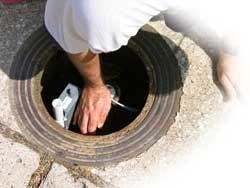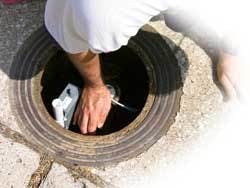Water District Uses AMR to Handle Rapid Growth
The Las Vegas Valley Water District (LVVWD) is a not-for-profit agency that provides water to much of the Las Vegas valley. The region has experienced phenomenal growth, adding about 2,000 water meters per month over the last eight years. This growth has put significant pressure on LVVWD to collect data from all of the new meters, as well as dramatically increased the need to monitor water conservation programs.
The LVVWD Board of Directors made a policy decision in the late 1990s that future funding would be focused on technology improvement instead of hiring additional employees. As a result, the district has pursued Automatic Meter Reading (AMR) as a strategy to offset the rapid growth of the meter reading workload.
“A cost/benefit analysis identified some $32 million in direct hard cost savings over the life of the hardware with an additional $44 million in related benefits to our Customer Service and Conservation Divisions,” said Meter Services Manager Mike Kebles. “The district’s goal after full deployment is to reduce the number of manual meter readers from 25 to a Mobile Reading workforce of six.”
The LVVWD has an open bidding process for purchasing water meters, resulting in a diverse mixture of meter manufacturers and types. Many of these meters are relatively new straight-read units without the electronic output needed for many AMR systems. District management determined that it would not be cost-effective to replace these accurate and reliable meters. Instead, their specifications called for an AMR product that could read all existing brands and types of meters in the system.
The LVVWD selected the Datamatic Firefly® AMR system with mobile Roadrunner data collection hardware and software. The Firefly technology can read pulse and encoded registers and can optically recognize the passage of the sweep-hand on LVVWD’s majority of standard meter registers.
“An added bonus of this system is its capability to store and provide water usage history profiles,” Kebles said. “The Firefly units are programmed to capture 74 days of hourly reads, giving the LVVWD the capability to analyze the data for leaks and other consumption anomalies.”
Handheld and mobile computers are used to collect meter data during the transition from manual meter reading to AMR. Upon completion, all meters will be read using vehicle-mounted data collection units.
“Each mobile meter reading route currently reads from 2,500 to 3,000 meters per day versus 600 manually,” Kebles said. “Manual meter reading routes are being combined to form new larger AMR routes, but the historical geographic design of the routes has not been re-evaluated. The ultimate goal is 6,000 to 7,000 reads per mobile unit per day. Currently, 260,000 meters have been retrofitted since 2000, with an additional 125,000 meters scheduled to complete the project. Current rate of deployment is 2,500 meters per week.”
The LVVWD has experienced minimal problems with radio reception of the meter data transmitted from within the meter boxes. Installation was outsourced to Datamatic to create single-source accountability for the overall operation of the AMR system. The company sub-contracted the installation of the AMR meter modules.
According to Datamatic Vice President Andy Kercher, “Maintenance is accomplished by the district’s in-house staff after acceptance. As we understand, they’ve experienced little operational problem with the equipment. The Datamatic team projects battery life of the Firefly units to be 10 to 15 years due to the low-power requirements of the optical-sweep equipment design.”
Implementation Issues
As the project began, Datamatic first outsourced the installation of the units to an installation sub-contractor who had some difficulty assuring that the units were programmed properly in the field with the meter reading of the meter, and resolution of programming issues was not timely. The contract was subsequently modified to provide appropriate incentives to correct these issues.
Some problems were encountered with the waterproofing of the electrical connections and the tuning of the Firefly optical sensors to address variable conditions of existing meter registers, including scratched or dirty lenses. These problems were resolved through product improvements enabled by the collaboration of the LVVWD and Datamatic.
Initial data management problems were experienced from meter data being outdated by the time the installation contractor arrived at the site of each meter to be retrofitted. This was due to interim meter exchanges occurring between the time the work orders were created and the time the work was performed. Improved processes resolved these issues.
Employees have been kept well informed of the progression of the AMR project and meter readers have responded by re-training to higher-level positions. Extensive communication has been focused on customers and response has generally been positive.
Best Practices
According to Kebles, utilities need to keep the following in mind:
− Collaboration between the utility and the AMR supplier is needed to fit the right technology to the organization, modify hardware and software as needed along the way, and work to optimize overall system performance. For example, the LVVWD and Datamatic are working together to upgrade the Firefly modules to be “self-provisioning” during installation. This will reduce the manual programming processes now required of the installation contractor. Further, installation would be significantly streamlined if meter suppliers installed the AMR modules during the manufacturing process, avoiding the need to retrofit the meters after delivery to the utility.
− Critical success factors for AMR implementation are selection of the right AMR product to meet organization requirements, and hiring of the right contractors to perform implementation activities. In order to accomplish these objectives, the organization must know precisely what it is trying to achieve and identify the specific data it needs to do that. During implementation, the most challenging task is data management and administration, both for meter inventory and work order tracking, as well as for meter reading data.
− Accountability for successful accomplishment of AMR implementation tasks is critical to project achievement. This was accomplished by LVVWD assigning responsibility for both meter reading and meter maintenance to a single manager.
About the Author:
Scott Durham is the Vice President of Sales for Datamatic and has been involved in the delivery of Enterprise data collection solutions for over 20 years.



